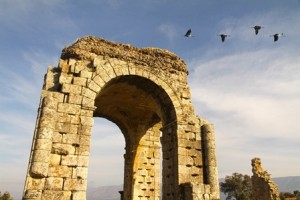
Photos courtesy of Extremadura Tourism
By Carolyn Worthington
If you think “bustard” is a misspelled curse, a “kite” as only something you flew as a kid, or a “tit” is an inappropriate word, then you are as ornithologically challenged as I am. But, like me, you may find enjoyment in the serenades of chirping, singing birds as you commune with nature, spot wildlife, or are mesmerized by the ever changing sky as the sun rises and sets.
The birds around the small farm where I live provide the orchestra for my appreciation of nature, but, sadly, I really don’t know each musician. I appreciate their concertos, but lack the knowledge to admire them except for the annual arrival of the swallows at the barn or the flock of turkey vultures that sometimes sit all in a row on our fence posts, wings spread to six feet, enjoying the sun.
This all changed recently when a trip to Spain transformed my two-dimensional world into three… and I was soon to learn that a Great Bustard, a Black Shouldered Kite, and a Great Tit were all birds to be admired.
Birding Trip As A Lark
 My birding education came somewhat as a lark, so to speak. While planning a trip to Spain and making a decision on where to go and what to do off the beaten track, I became intrigued with the region of Extremadura. Like many travelers to Spain, I had already visited Madrid. This time I decided a road trip beyond the cities might be a good way to really get to know the country and learn more about its landscapes, culture, food, and history. Rather than just drive around, I decided to pick a new theme that seemed quite popular in Spain: Birding.
My birding education came somewhat as a lark, so to speak. While planning a trip to Spain and making a decision on where to go and what to do off the beaten track, I became intrigued with the region of Extremadura. Like many travelers to Spain, I had already visited Madrid. This time I decided a road trip beyond the cities might be a good way to really get to know the country and learn more about its landscapes, culture, food, and history. Rather than just drive around, I decided to pick a new theme that seemed quite popular in Spain: Birding. 
Of the 17 contrasting Spanish regions, it was hard to choose just one. However, Extremadura, southwest of Madrid, snuggled next to Portugal and just north of Andalusia, called to me. It seemed to offer all of the wonderful things I hoped for in a travel off the beaten path; special regional cuisine and wine; history; and culture. And, of course, birding.
The tipping point for me, however, was something very unusual. Perhaps, Dirk Hilbers, author of Extremadura, Spain, published by Crossbill Guides Foundation, says it best. His words captured my imagination and solidified my decision to do a “road trip” in Spain:
Paradise.
 That is the shortest description of Extremadura in spring. Old, majestic oaks in a rolling green carpet of pasture. Little lambs frolicking through endless orchards, their mothers standing knee-deep in wildflowers. In the pools, happy black pigs are up to their bellies in mud. Little ribbons of white flowers dangle from their snouts. A stork glides down to its nest on an old church, where it is greeted by its partner and the rest of the stork community, numbering a dozen or more. Welcome to Extremadura…
That is the shortest description of Extremadura in spring. Old, majestic oaks in a rolling green carpet of pasture. Little lambs frolicking through endless orchards, their mothers standing knee-deep in wildflowers. In the pools, happy black pigs are up to their bellies in mud. Little ribbons of white flowers dangle from their snouts. A stork glides down to its nest on an old church, where it is greeted by its partner and the rest of the stork community, numbering a dozen or more. Welcome to Extremadura…
For a long time, it was scorned by the Spanish and disregarded by the rest of the world. But this attitude has taken a 180-degree turn since eco-tourism became in vogue. And with good reason, for the region has great things in store for all sorts of travelers.
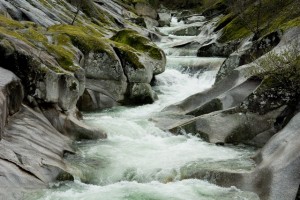 If you enjoy bird watching, Extremadura offers you skies filled with eagles and vultures, and steppes alive with Little and Great Bustards. If you love to search for beautiful wildflowers, the high number of Mediterranean species will dazzle you, especially in the mountains. In the endless orchards and along the flower-fringed streams, you’ll find yourself in the Garden of Eden.
If you enjoy bird watching, Extremadura offers you skies filled with eagles and vultures, and steppes alive with Little and Great Bustards. If you love to search for beautiful wildflowers, the high number of Mediterranean species will dazzle you, especially in the mountains. In the endless orchards and along the flower-fringed streams, you’ll find yourself in the Garden of Eden.
Nearby rocky mountain slopes and merciless steppes show a beauty of a much more rugged kind. Remote regions invite you for a hike, and in the evening you can quietly enjoy a wonderful meal in an old plaza while watching the geckos hunt around the streetlights attached to medieval houses and palaces.
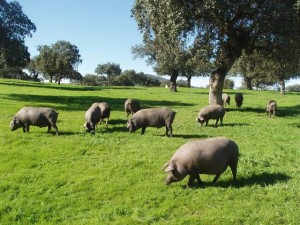 Extremadura is a rollercoaster for every nature enthusiast, not only astonishing in its diversity but also in its genesis. If you have come to see a wilderness without a trace of human influence, you have chosen the wrong spot. The majority of Extremadura’s valuable natural areas evolved through the interaction between the land and its inhabitants. This makes the region into a must-see example of the way nature and culture can enhance each other.
Extremadura is a rollercoaster for every nature enthusiast, not only astonishing in its diversity but also in its genesis. If you have come to see a wilderness without a trace of human influence, you have chosen the wrong spot. The majority of Extremadura’s valuable natural areas evolved through the interaction between the land and its inhabitants. This makes the region into a must-see example of the way nature and culture can enhance each other.
Bird watching? A trip around watching birds?
I headed off for five days to see what Dirk Hilbers described, guidebook in hand, and what the fascination of bird watching was all about.
 Extremadura lies about a three-hour drive southwest of Madrid, an easy drive along the beautifully maintained highways. You quickly leave the city by car and are surrounded by gorgeous countryside at every glance.
Extremadura lies about a three-hour drive southwest of Madrid, an easy drive along the beautifully maintained highways. You quickly leave the city by car and are surrounded by gorgeous countryside at every glance.
The meaning of “Extremadura” is not known but some speculate the etymology might stem from the extreme, or other side, of a river, the Duero, north of the region. Folklore has it that shepherds brought their sheep there during the winter to find lush pastures. Around the size of Denmark, Extremadura is a part of Spain that has not changed much in a very long time. If the explorer Herando DeSoto, the first European to explore what is now the United States, came back today to this region where he was born, the landscape would be quite similar.
Finding the right guide
As a non-birder, I knew I would be lost without a guide. I was fortunate to explore birding in Extremadura with the help of professional birder and guide, Martin Kelsey. Non-birders typically view bird watchers as a bespectacled person dressed in baggy clothes and floppy hat and carrying the ubiquitous binoculars. My image was soon to be shattered when I met Martin and a group of experienced “birders” who were athletic, highly technological with their several thousand dollar scopes, well-travelled, and very fun.
 Martin, who bears a strong resemblance to an older Harry Potter with his round glasses and command of proper English, is virtually a walking, talking Google resource for ornithology. Like Potter, he is a wizard in his ability to make the activity of watching feathered creatures actually very exciting.
Martin, who bears a strong resemblance to an older Harry Potter with his round glasses and command of proper English, is virtually a walking, talking Google resource for ornithology. Like Potter, he is a wizard in his ability to make the activity of watching feathered creatures actually very exciting.
He began birding 60 years ago as a child at his home in Essex, England. His passion led him to study ecology at the University of East Anglia and the Edward Grey Institute for Field Ornithology in Oxford to complete a doctorate on the ecology of Marsh Warblers. He then spent three years studying birds in the Amazon rainforest with the British Ornithologists’ Union. There he met Claudia, who later became his wife.
“We met on the banks of the River Amazon where I was studying the birds in the national park and Claudia was completing her studies in tourism, helping to set up a visitors’ center there,” Martin told me.
Returning to the UK, he worked for BirdLife International for five years, before joining Save the Children UK, spending four years living in Colombia and then four years in India, as well as a short time in Ethiopia. Their son, Patrick, was born in India.
The passion to live and work in a paradise for birds then drew the family to Extremadura nine years ago. They now operate a country guesthouse for birders. Over the years, Martin and Claudia have painstakingly restored a traditional old house, typical of Extremadura. They are located at the edge of a little village beside the gentle hills of the Sierra de los Lagares, 10 minutes from the medieval town of Trujillo. Casa Rural El Recuerdo is an ideal base from which to explore Extremadura.
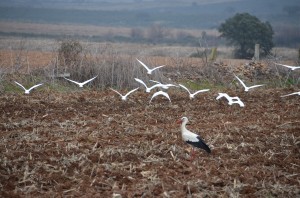 To watch birds with Martin is like taking a gastronomic tour through Paris with either of the French chefs Jacques Pepin or Alain Ducasse by your side. Not only is he a wealth of information, he willingly shares his lifetime of knowledge in an easy-to-understand fashion for us novices. With an ever-present smile on his face, he tackles even the silliest of questions.
To watch birds with Martin is like taking a gastronomic tour through Paris with either of the French chefs Jacques Pepin or Alain Ducasse by your side. Not only is he a wealth of information, he willingly shares his lifetime of knowledge in an easy-to-understand fashion for us novices. With an ever-present smile on his face, he tackles even the silliest of questions.
As a bird watcher, Martin says of himself: “I am not the kind of bird watcher who likes to check off lists of birds I have seen. I prefer to learn about the birds, their history, their migration routes.” With his skill, he may or may not be fun to watch a movie with. He can spot a bird error instantly, like the one in the very British Mary Poppins’ “Spoonful of Sugar” scene in which a robin appears. “I immediately recognized the error,” he says, “the robin here has a brighter orange chest. That was an American Robin!”
With Martin’s guidance, looking through high-power scopes, standing in fields, alongside marshes and on mountaintops, I began to see, to really see, how exciting the details of the birds can be. If you are a professional birder or a newbie, Extremadura with its endless variety of species is definitely the place to immerse yourself.
What birders say about their passion
The nice thing about joining a group of passionate birders with a guide like Martin is you learn first hand what they love about it. One birder in my group, Laura Kammermeier, is also a writer and the publisher of NatureTravelNetwork.com. She expressed her passion this way:
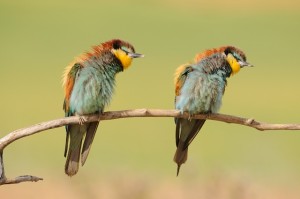
Bee-eaters
Bird watching ignites a fire inside of me like nothing else can. Ordinary life can be rather dull, but when you travel for birds, you are constantly in a state of discovery and amazement. That feeds my soul, makes me smile, makes me nicer, happier, even more attractive due to the shine in puts in my eye. It also keeps me fit by taking me away from the desk, walking through all type of terrain. Sharing the birding experience with others on the road is even more interesting, because bird watching can turn strangers into trusted friends literally in an instant. I now have friends on every continent. The reason I watch and photograph birds is so that they may remain free while their wildness lives inside of me.
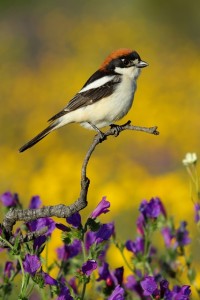 Frank Wharram, who runs tours himself, told me:
Frank Wharram, who runs tours himself, told me:
As an avid but aging hiker, climber, and cyclist, I now find that creaking knees no longer allow me to enjoy these pastimes to the full. I have always loved birds and always carried binoculars around but since the death of my wife two years ago I have now taken up birding more seriously. Why? Because birding persuades me to get out of the house into beautiful countryside, breathe the fresh air, and get some more gentle exercise. On top of this it takes me to places where I can see beautiful birds, which come in the most exciting and exotic colours but also inspire me by their devoted parenting and hard work in searching for food, and of course they love to show off their beauty and agility!
For other birders, the reasons varied from the thrill of the quest, the spirit of the hunt without killing the prey, a way to understand the landscape, an opportunity for authentic travel, and a way to find an intimacy with a place.
Plenty to see and do in Extremadura
As a group, we saw some 116 birds on the trip. Some of my favorites were spotted at the Monfrague National Park. The Griffen and Black Vultures were amazing to watch as they caught a lift from the wind and took off on a glide in search of food. We saw the migratory Egyptian Vultures, part of the 20 to 30 pairs there, as they were arriving along with the smaller, Pena Falcon with its black and white tail. The Golden, Spanish and Imperial Eagles and the Binellis were just coming across the Straits of Gibraltar after wintering in Africa. There are 128,000 cranes in Extremadura, and we saw some of them.

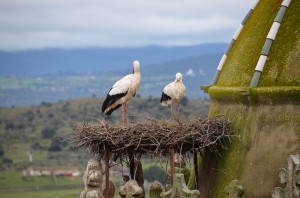
Once you start zoning into watching for birds, you become more aware of them around you. Of course, some were hard to miss, like the storks that set up nests seemingly wherever they please and sometimes in the most unusual places, from the tops of church steeples to construction scaffolding. Or the four-foot-tall pink flamingoes in that had just migrated that day from the south and were feeding in the lagoon at a government nature center.
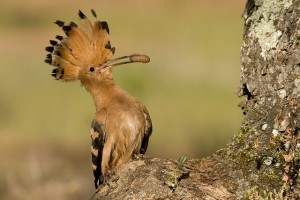
Hoopoe
You can’t help but be carried by the enthusiasm of a birder who has just seen a “hoopoe” with its magnificent crown of features, a flock of meadow pipits or a fantailed warbler making its zit-zit-zit sound. And that, as Martin would say, is a “jolly good” day.
I returned to our farm in Pennsylvania determined to better appreciate the calls and coloring of the robins, swallows, cardinals, hawks, buzzards, and woodpeckers that sing and flit about the property. Certainly a great sampling of American birds but nowhere near the variety and species of a very special place . . . Spain’s Extremadura.
Photos courtesy of Extremadura Tourism
Healthy Aging Magazine full article: Birding in Extramadura












